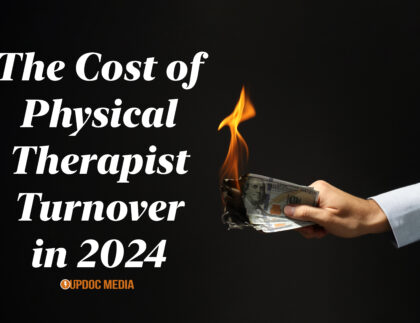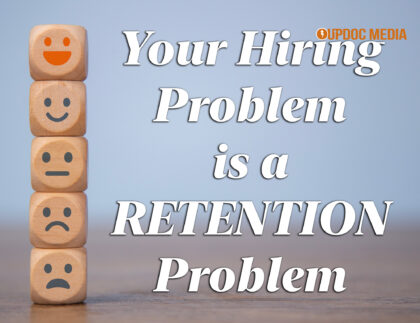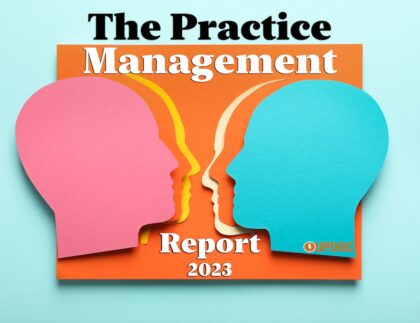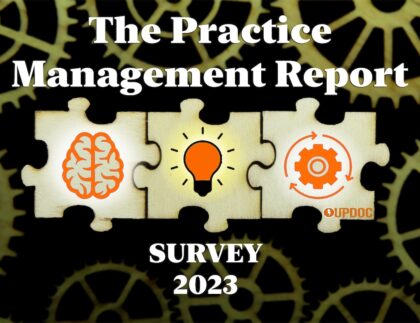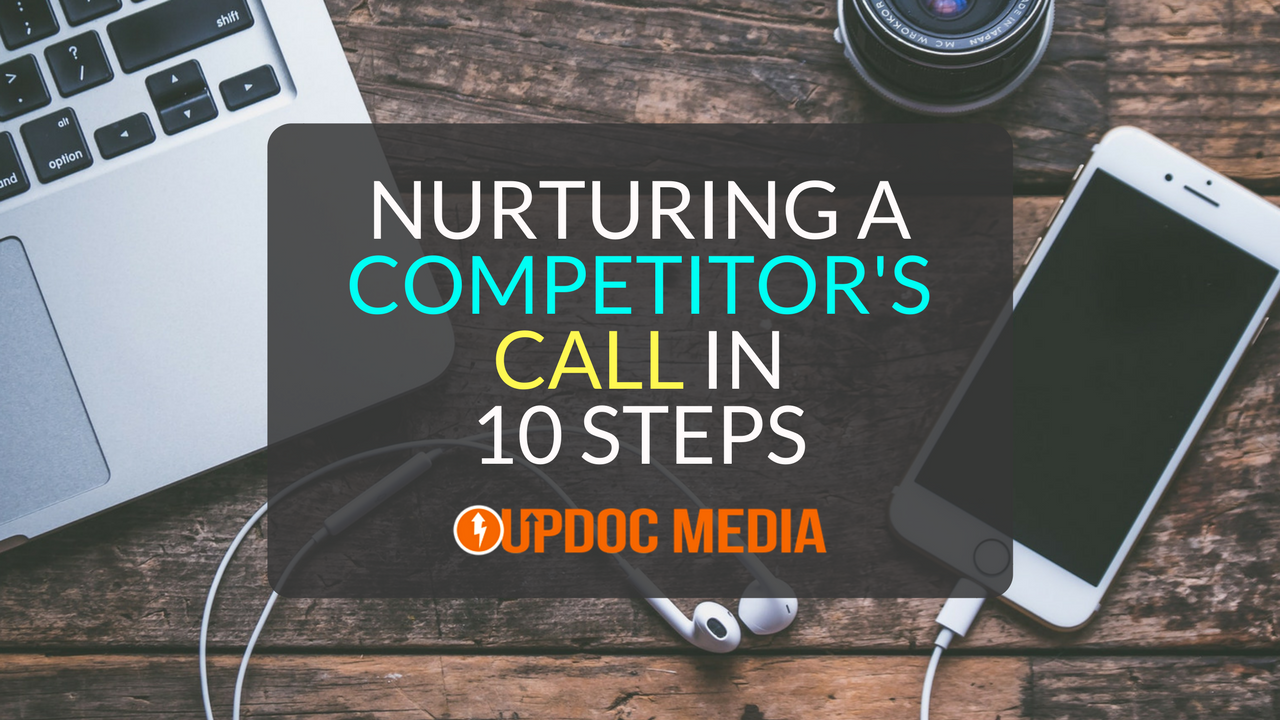
That’s right — AND — that’s how you know things are truly moving in the right direction. This is happening because all your content, your targeting factors, the design of your customer conversion journey — all in sum, has made it possible for shoppers to find you first… before they found your “competitors.”
Now, it’s on your reception team to nurture that call from accidental inquirer to purchasing customer 😉
Nurturing A Competitor’s Call In 10 Steps
1. Receive Strategically
“[Insert Greeting], this is [Team Member Name]. How may I direct your call?”
Notice, the first you did NOT do is identify the business right away. The caller is now talking to a person. This is by design; and, causes relational connectivity — something that will be key in the mere moments to follow. While most businesses identify themselves right away, and, this isn’t wrong… consumers looking for your competitors are likely to take a pause when you’ve told them they’ve reached the wrong place. Some might stop to confirm they called the wrong place, or perhaps, that there is an unexpected anomaly — like a multi-business front desk, or something of that nature. The truth is, there will be more that will just hang up, right then and there. Some will call back to try again, just as a sanity check. Others, will just plain move on.
For these reasons, answering in the fashion “as a person” engages the conversation without the easy detachment of being “an entity.” If they hang up, they are now hanging up with a name… versus the non-identity of “a company.” This also allows empowers them to begin sharing their story — their journey and reason for this call.
This, is the moment you’ve been waiting for. It’s on you to identify that need, right away. Is it just information gathering? Did they hurt their back? Perhaps they are looking for a place that “does massage.” Maybe, they are just checking to see if you can take their insurance.
Whatever that reason is, make sure you identify it NOW — jot it down on a notepad, type it into your call tracking intake form… put it SOMEWHERE so that you can refer back to it. Once the person is done answering this initial question, it’s your turn to affirm their needs.
2. Quickly Affirm The Reason For The Call
This moment needs to be severely brief and needs to result in a Yes/No response from the caller.
“So, you’re calling about your _____?” or “I understand. You have a ____ you need resolved ASAP.” — anything of that nature will work.
Yes/No.
Done. It’s a micro-point in active listening that will pay dividends.
3. Capture Contact Information
“Okay. Thanks! I can definitely help you with that. Before we move on, could I get your name, best call back number in case the call gets dropped, and email — just in case I need to send you extra information?”
Boom. Boom. Boom.
The request should be very quick, as it is practically standard with any call center or help desk experience. As a matter of fact, this should be happening to EVERY INBOUND CALL that comes into your practice. If you fail to do this, how will you possibly nurture these leads? It’s that simple.
4. Receive “The Moment”
“Great. Thanks for that information! Now, here at [Insert Practice Name Here] we have several clinicians that are great with your [Insert Need Here].
Now, this… THIS, is when most folks drop the ball. It’s that moment they tell you: “Well… I’m actually calling about [Insert Competitor Here].”
It’s easy to freak out when you hear that over the phone.
Here’s what to do. Receive it. Take it. It’s never easy. Accept it. It’s like defending a body shot in boxing. If the punch is on its way, it’s going to land. You can either cover up and take it. Or, do nothing and let it ruin you. Believe it or not, absorbing this moment is critical, and is indeed, a singular step in this process. Mentally processing that “this is happening” allows for the reception team to switch gears from receiving to converting — converting someone else’s lead, potential customer, and quite possibly entire social sphere of influence… into YOUR future brand champion.
Boom. Onwards to Step #5.
5. Remember the 70/30 Rule
There is a foundational principle in sales called the 70/30 Rule. By nature, it really isn’t that different than the seemingly cosmically universal 80/20 Rule of life. In any case, the 70/30 Rule dictates that the customer talks 70% of the time and the salesperson talks 30% of the time. The caller must feel listened to, understood, cared for — treated and regarded as if they are already a paying customer.
This next step is the mental switch from inbound query filling, to now full scope conversational sales.
Again, this is another seemingly “non-step” that is of paramount importance; this step creates a shift from the typical inbound, information gathering, schedule confirming action steps — to a far more organic experience received by the caller, mindfully delivered by the reception team.
70/30. You got this. You have just one question to ask, then LISTEN!
6. Inquire About Their Journey
Here’s the question you must ask:
“Oh! We know that [Competitor] quite well. But, real quick… Would you mind telling me about what got you here? What have you tried? What has worked, what hasn’t?”
Asking about their experience opens up an entire new typology of human interaction: Storytelling.
Let them reveals as much as the conversation will allow for. They may or may not have already tried the same discipline as the clinical practice which you have to offer. They might have tried a bunch of things, or, this might be the first time trying anything. Whatever the case, storytelling serves to reveal the customer journey thus far AND create even more trust.
After all, by this time in, the call is realistically only a minute or two old. It’s a young call and 20-30 of those seconds were spent on introductions and contact information gathering. So realistically, even if this was a slower call and is now 90 seconds old, the last 60 seconds has been all about the caller’s experience thus far.
THIS. IS. POWERFUL!
7. Make Your Transparent “Confession” and Counter-Offer
“Well, I know you weren’t looking for us, but I’m really glad you called — our doctors, therapists, clinicians are excellent at helping people going through what you’re going through. I know that if you were to give them a chance, they’d take really good care of you.”
Implicitly: Just as I have been doing.
Point of contact brand experience is something many clinic based healthcare companies under-train and under-appreciate. The value statement here is monumental. First, are there any companies out there that would be willing to take the time to be honest, and… say so?! Few. At least, that is the thought process behind the consumer’s perspective — the only thing that matters for these past 60-90 seconds and the next 60-90 seconds. Secondly, most consumers (healthcare or general) expect a poor experience when calling into ANYTHING.
It’s likely going to be an automated reception, or, someone who just takes a bunch of calls and puts you on hold… likely dropping your call in the process.
All these details are beginning to add up.
The fact that you asked for a call back number in case of a dropped call, the fact you’ve asked for an e-mail address in case you need to send more helpful information, the fact that you (the reception team who represents the practice) have taken the time (which, even if it was severely slow and amounted to 2-3 minutes thus far)… to authentically listen to and connect with another person as a human being…
ALL THIS… is a welcome breath of fresh air.
So, you’ve made your ask. Your caller will either go for it and schedule with you, or, they’ll politely decline.
8. Offer A Serendipitous Alternative
If they decline, make sure you express your appreciation that one’s healthcare is a very personal choice and has important financial implications. We, the company, respect that. Then, having once again delivered affirmation and understanding to their situation, you are well positioned to offer an alternative:
“If you’d like, we actually offer free screenings, would you like to come in for one? There’s absolutely no charge, no hidden fees… it’s just a service we offer to the community.”
It’s kind of like when you’re going out for a meal at a food court and you have a specific cuisine in mind. As you walk through, not exactly finding the place you were searching for, someone hands you a free sample. You shrug to yourself, “Well… it’s here. And, it’s free.” and, try out the morsel which ultimately ranges from “not bad” to “pretty good!” #NoRegrets #FreeFood
The bad news is this: There will be a natural percentage of calls that will drop off.
The good news is this: There will be a percentage of calls that will convert to free screens and yet another percentage into full courses of care which you would have NEVER been previously able to capture.
9. Offer A Resource On Exit
So, what if they still say, “No?”
First, thank them for their time and offer to help them search, right then and there — potentially connect them with the party they wish to reach. Again, this is all about a brand experience that goes above and beyond. What’s the difference between extraordinary and ordinary? EXTRA!
This extra step will show the caller how much good service means to you, making them reflect on their decision not to go with you. This will also show your “competitor” that you’re really not competition. You’re in a completely different level of play. Moreover, this also allows you to field one more ask, regardless of if they are agreeable to you searching and/or connecting them with the originally desired party.
During this step, it’s a prime time to bring up: “Well, if it’s okay with you… since we have your email, we also have a free resource I’d be happy to send you about your [insert problem here]. It’d be a one time thing, you wouldn’t be getting a newsletter or anything after. Would that be alright?”
It’s at this point you’re basically killing them with kindness. What type of practice has representatives that are willing to go THIS FAR to satisfy a customer, prior to fee fulfillment, even at their own seeming detriment? All to genuinely understand, care for, and help the caller???
10. Say, “Thank You!”
Regardless of the response in Step #9, it’s still on the reception team to say, “Thank you.”
“Thanks again for your call. Hope your ____ feels better!”
And, insert a quick reminder to expect an email, should they have said, “Yes” to the free resource. Of course, in the free resource email, you’d have fabulous content with a savvy call to action for them to reach back and resume the dialogue… another blog post for another time 😉
This blog post represents one of an infinite number of versions for these ten steps, all of which need to be customized and formulated for you — your practice, your brand, your people. You can also be sure that those who give some type of “Yes” will likely stop by your website, online reviews, and social media channels as well. After all, over 80% of healthcare consumers will choose their next provider via that handy dandy search bar.
Now, it’s important to address a few things:
- Will everyone connect as planned? Nope!
- Will some think the approach is initially aggressive? Surely! Those aren’t the people you are trying to reach.
- Will you need to plan some training time for the reception team? Absolutely.
- Is every step required? Nope.
- Is every step in order? Nope. In fact, these ten steps can be highly non-linear, depending on the direction the caller chooses to take.
One final thought. Today’s post covers scratches the surface on the classical dynamic of marketing vs receiving. Marketing brings the leads to the door, reception must welcome with open arms. As with all successful approaches — it’s all about the ecosystem. It’s never just one thing that brings to success, it’s all of them.
If this post had piqued your interest to sharpen up your team, we have more resources for you!
- The Digital Marketing Pre-Flight Checklist
- The Future of Digital Media
- Where Should You Be Spending Your Marketing Dollars?
Finally, if you’re thinking your company could use a more robust approach to starting the next quarter with a strong cadence, check out our intensive program: The Business Optimizer!



